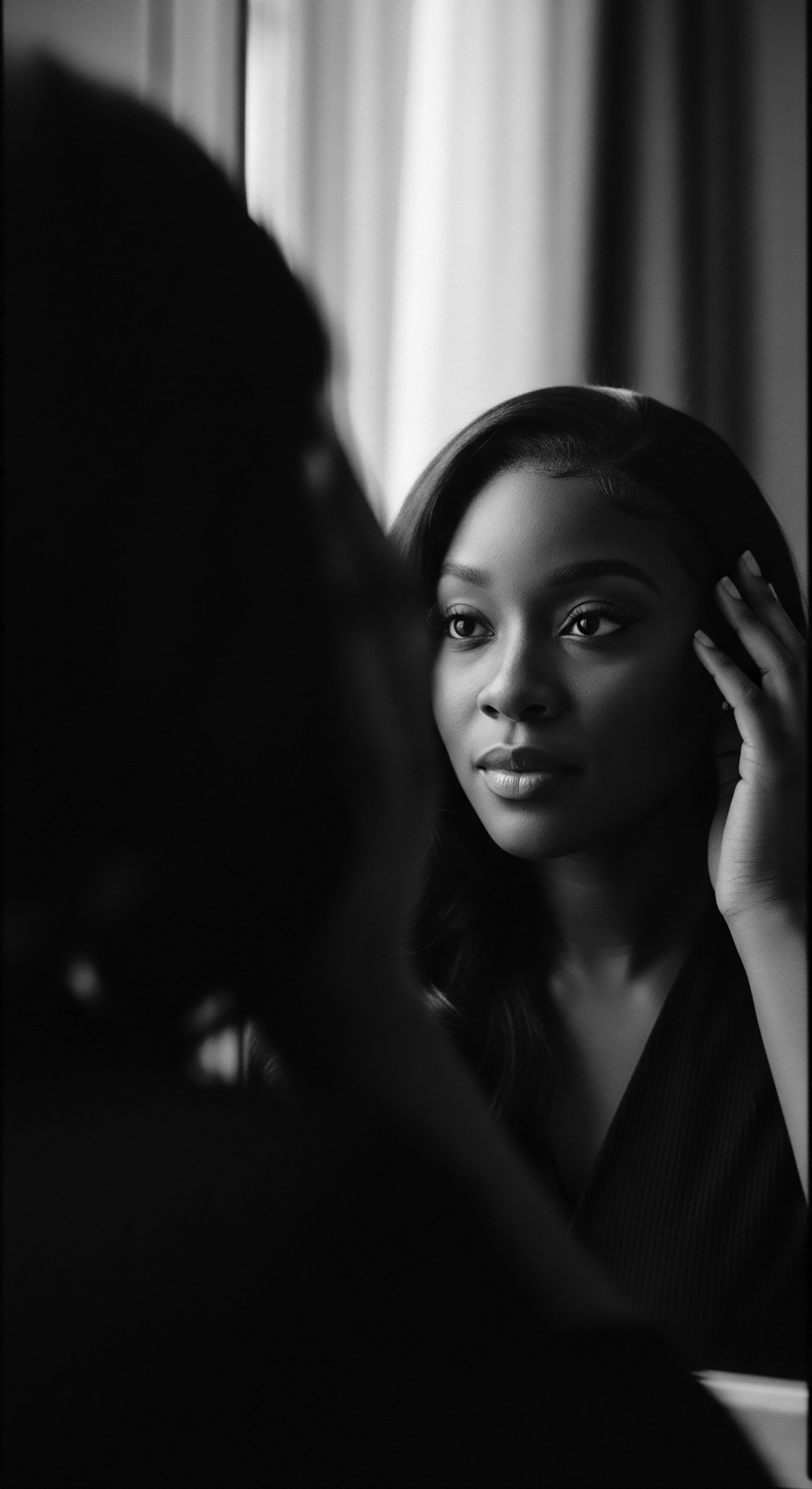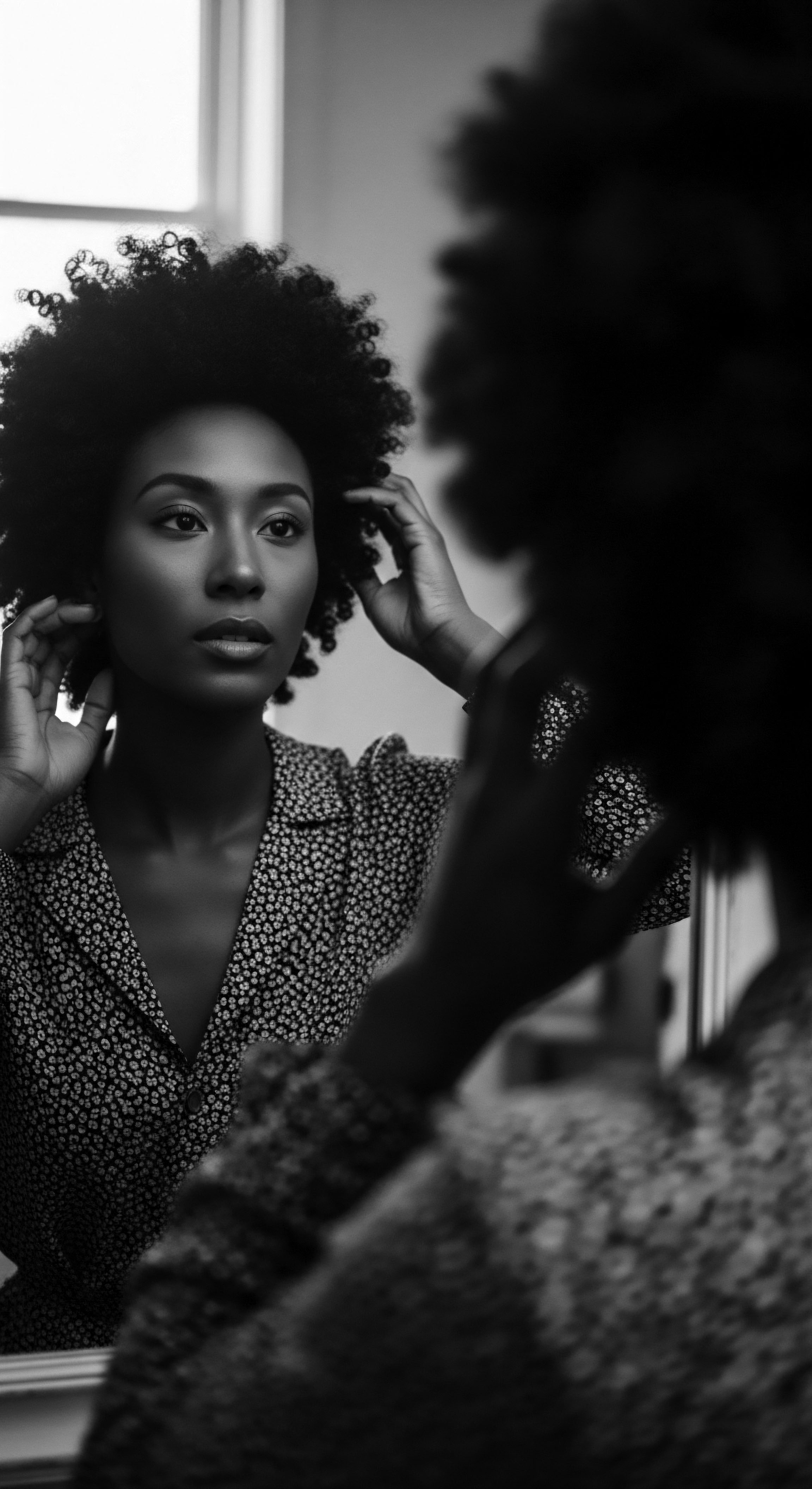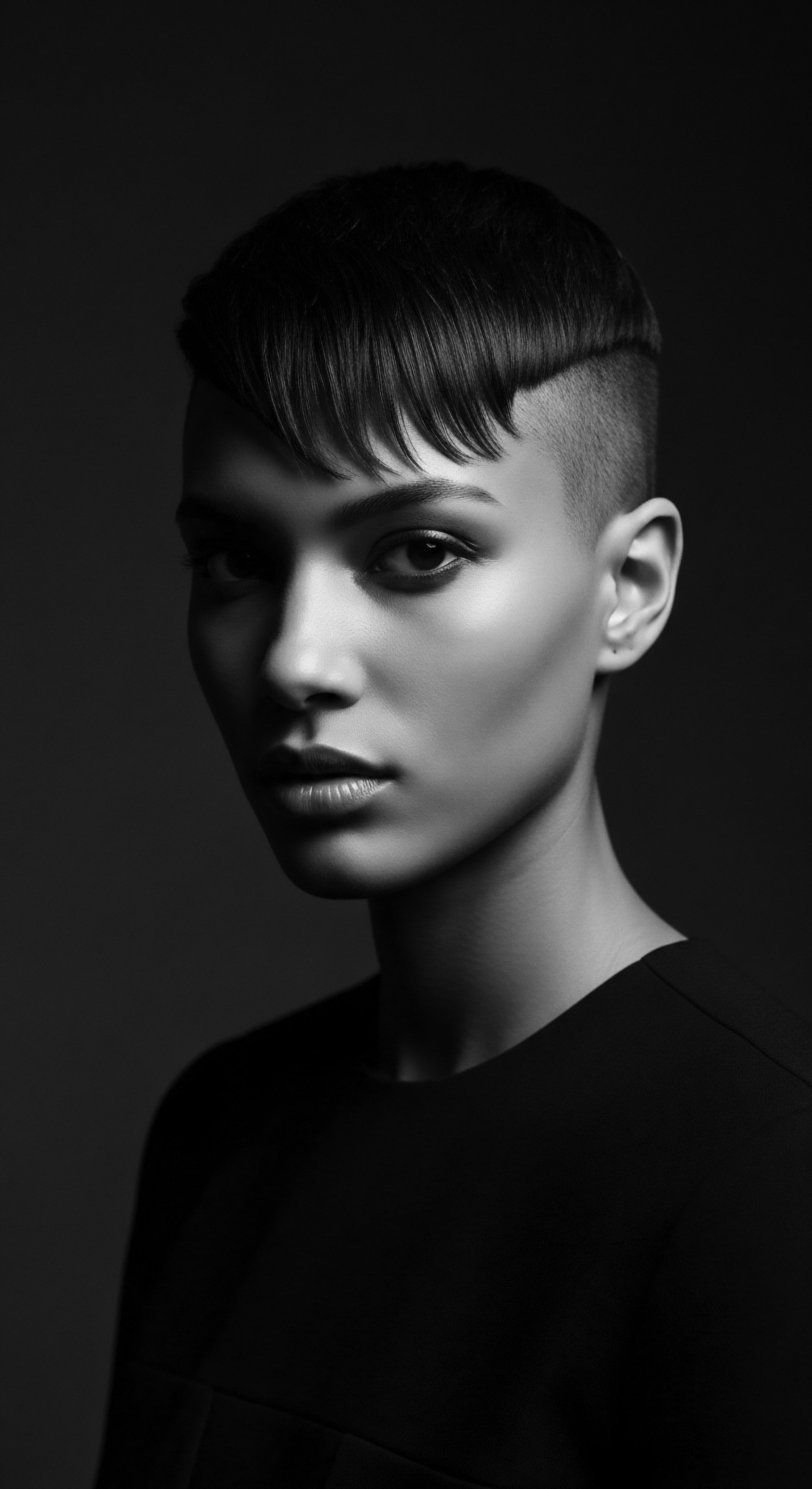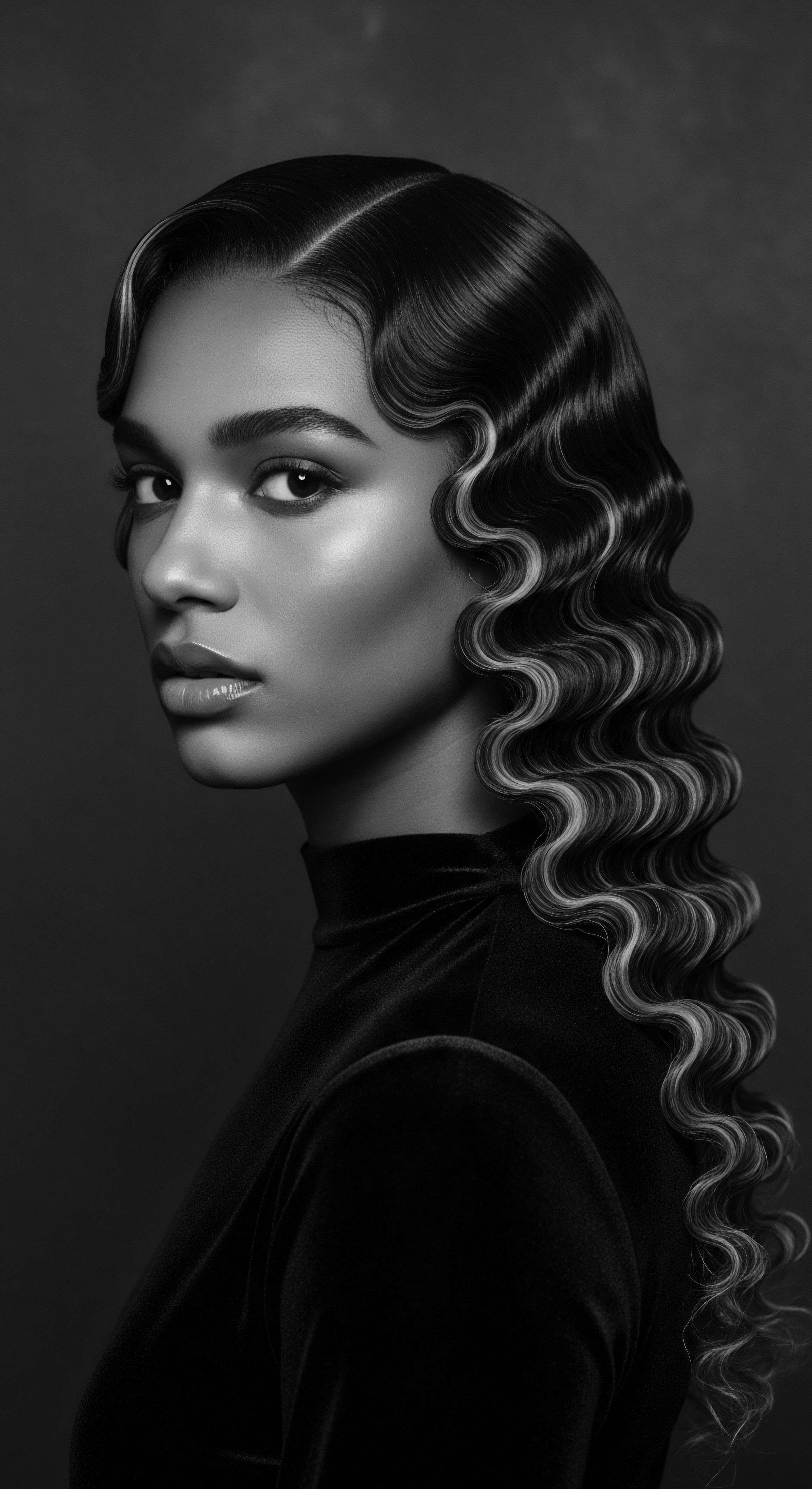
Fundamentals
Spiritual Liberation, as understood through the rich lens of textured hair heritage, delineates a profound journey toward holistic freedom. It is a liberation not merely of the physical self, but of the spirit, mind, and collective identity, deeply intertwined with the stories held within each curl, coil, and strand. This understanding recognizes hair, particularly Black and mixed-race textured hair, as far more than aesthetic adornment. From ancient times, hair has served as a conduit to the divine, a marker of societal standing, and a testament to an individual’s journey through life’s intricate passages.
The fundamental meaning of Spiritual Liberation, therefore, rests upon the recognition and reverence for one’s inherent being, commencing with the elemental biology of textured hair. Our hair, in its natural state, echoes ancestral wisdom, carrying the genetic memory of resilience and adaptation. It is a biological marvel, each strand possessing unique structural properties that allow for its remarkable versatility and strength.
Before the ruptures of forced displacement and colonial influence, hair care was a cherished communal practice, often imbued with sacred rituals. These practices were not simply about cleanliness or style; they were spiritual acts, linking individuals to their lineage and the cosmic order. The earliest care rituals for textured hair involved a deep connection to the earth’s offerings, using natural ingredients derived from the abundant lands of Africa. These traditions laid the groundwork for a symbiotic relationship between self, community, and the spiritual realm.
Spiritual Liberation begins with honoring the inherent wisdom of textured hair, recognizing it as a sacred connection to ancestral truths and a pathway to self-acceptance.
The concept extends beyond personal well-being, encompassing the broader cultural and historical narratives woven into the very fabric of Black and mixed-race communities. It speaks to the dismantling of imposed beauty standards that sought to diminish the intrinsic beauty of textured hair. This journey of liberation often involves a return to traditional practices, celebrating styles that reflect authenticity and pride.

Echoes from the Source ❉ Hair as an Ancient Vessel
For millennia, across diverse African societies, hair held exceptional meaning, serving as a dynamic language system. Hairstyles conveyed a wealth of information about a person’s age, wealth, profession, relationship status, and spiritual beliefs (Mbilishaka, 2018a). It was considered the body’s highest point, symbolically closer to the heavens, making it a sacred conduit for communication with the unseen world, from birth to death (Mbilishaka, 2018a). The Yoruba people of Nigeria, for example, braided their hair to send messages to their deities, indicating that hair care extended beyond external appearance to encompass inner spirituality (Shedavi, 2023).
This deep spiritual connection meant that the hair itself became a canvas for storytelling and a repository of collective memory. Complex braiding patterns, often requiring hours or even days to complete, were not only artistic expressions but also powerful visual representations of cultural heritage and social order (Byrd & Tharps, 2002; Genesis Career College, 2022). The careful intertwining of strands symbolized the interconnectedness of community, family, and spiritual lineage.
- Adornment ❉ Beads, cowrie shells, and other decorative elements were often incorporated into braided styles, each carrying its own symbolism related to wealth, spiritual protection, or marital status (Our Ancestories, 2025; Afriklens, 2024).
- Ritualistic Practices ❉ Rituals like the baby naming ceremony among the Yoruba and Wolof, where newborns’ hair was ritually shaved as an offering to ancestors, underscore hair’s profound spiritual role (Mbilishaka, 2018a).
- Social Markers ❉ In many societies, distinct hairstyles marked significant life passages. Young girls in Wolof culture might have partially shaved heads to indicate they were not yet of marrying age, while Maasai adolescent males dyed their hair red and grew long locs as part of their warrior initiation (Byrd & Tharps, 2014; Mbilishaka, 2018a).

Intermediate
At an intermediate level of understanding, Spiritual Liberation expands to confront the historical impositions that sought to sever the sacred connection between Black and mixed-race individuals and their textured hair. This deeper exploration acknowledges the enduring legacy of colonialism and slavery, which systematically denigrated African hair textures and traditional styling practices (Johnson, C.M.E. 2016; Dabiri, 2020). The aim was to dismantle a people’s sense of self and their ties to ancestral ways of being.
The journey towards Spiritual Liberation in this context often involves an active process of decolonization, both of the mind and of external beauty standards. It means recognizing how centuries of societal messaging have shaped perceptions of hair, instilling a belief that natural coils and kinks were somehow “unprofessional” or “unkempt” (Donahoo & Smith, 2022; Hamilton, 2023). This phase of understanding requires a deliberate unlearning, a conscious effort to reclaim and celebrate the authentic beauty of textured hair.
Such liberation extends into communal spaces, particularly salons and barbershops, which have historically served as vital centers for cultural exchange, storytelling, and community building within Black diasporic traditions. These spaces have long been sites where ancestral knowledge of hair care was passed down through generations, embodying “The Tender Thread” of continuity.
Spiritual Liberation is a conscious act of decolonization, systematically dismantling imposed beauty norms and embracing the inherent worth of textured hair within communal spaces.

The Colonial Shadow ❉ Imposed Standards and Cultural Erasure
The transatlantic slave trade marked a tragic turning point for the spiritual and cultural meaning of Black hair. Upon capture, slave traders routinely shaved the heads of enslaved Africans, a dehumanizing act intended to strip them of their identity and connection to their homeland and spiritual practices (Odele Beauty, 2021; Sieber & Herreman, 2000). This deliberate erasure aimed to break their spirits, detaching them from centuries of heritage where hair signified tribe, status, and divine connection. When hair regrew in the Americas, access to traditional tools, herbs, and oils was severely limited, forcing adaptive care practices.
In the aftermath of abolition, and continuing through various periods of racial segregation and apartheid, Eurocentric beauty ideals became entrenched. Coarse, kinky hair and traditional African styles faced profound stigmatization (Dash, 2006; Kuumba & Ajanaku, 1998). An industry developed to mimic European hair textures and lengths, propagating the notion that straightened hair was a marker of respectability and social mobility (Lester, 2000; Thompson, 2009).
The “pencil test” in apartheid South Africa, where a pencil inserted into hair determined proximity to whiteness and associated privileges, starkly illustrates how hair texture became a tool of racial classification and oppression (Johnson, C.M.E. 2016).

Resistance and Reclaiming ❉ Hair as a Collective Statement
Despite these pressures, Black hair consistently served as a powerful tool of resistance. During enslavement, some African women, particularly rice farmers, braided rice seeds into their hair as a means of survival and preservation of their cultural heritage, even creating maps to freedom within cornrow patterns (BLAM UK CIC, 2022; Dabiri, 2020). This embodied act of cultural preservation under duress speaks volumes about hair’s spiritual significance.
The 1960s saw a resurgence, with the Black Power movement popularizing the Afro as a symbol of defiance against racist beauty norms and pride in Black beauty (Erasmus, 2000; Dove & Powers, 2018). This was not merely a stylistic choice; it was a political statement, a declaration of identity (Tharps, 2021). The contemporary natural hair movement continues this legacy, with women globally returning to their natural textures as an act of self-acceptance and a stand against Eurocentric standards (Johnson, C.M.E. 2016; Matjila, 2020).
| Historical Practices (Pre-Colonial Africa) Using natural plant-based oils and butters for nourishment and protection (e.g. shea butter, palm oil). |
| Contemporary Practices (Natural Hair Movement) Seeking out products with natural ingredients, often echoing ancestral botanicals for holistic hair health. |
| Historical Practices (Pre-Colonial Africa) Communal hair braiding sessions as social rituals and knowledge transfer. |
| Contemporary Practices (Natural Hair Movement) Online communities, social media groups, and natural hair meetups for shared learning and support (Ellington, 2015). |
| Historical Practices (Pre-Colonial Africa) Hairstyles signifying intricate social status, marital status, or tribal affiliation. |
| Contemporary Practices (Natural Hair Movement) Styles chosen as personal expression, celebrating individual identity and collective heritage. |
| Historical Practices (Pre-Colonial Africa) The continuity of care practices, whether ancient or modern, serves as a testament to the enduring power of hair as a site of self-determination and cultural celebration. |

Academic
Spiritual Liberation, within an academic context, represents a rigorous scholarly understanding of the socio-historical, psychological, and biological dimensions of freedom attained through the reclamation of textured hair. This definition scrutinizes the intricate mechanisms by which Black and mixed-race individuals transcend the systemic oppression that has historically targeted their natural hair. It posits that this liberation is a dynamic, multi-layered process, integrating ancestral knowledge with contemporary scientific insights to forge a complete sense of self and collective well-being. Academic inquiry into this phenomenon draws from anthropology, sociology, psychology, and public health, dissecting the ways in which hair serves as a profound symbol of identity, resistance, and spiritual continuity.
The meaning of Spiritual Liberation in this sphere extends beyond superficial aesthetics, delving into the deep psycho-social implications of hair acceptance and rejection. It examines how centuries of racialization have conditioned perceptions, leading to internalized biases that impact self-esteem and mental health within marginalized communities (Darden, 2019). True liberation, then, involves a cognitive decolonization—a dismantling of imposed ideologies that linked desirability to proximity to Eurocentric hair textures. This intellectual and emotional disentanglement allows for a re-centering of Black hair as inherently beautiful and culturally significant.
Scholarly work in this area, such as the emergence of “PsychoHairapy,” provides culturally relevant frameworks for addressing mental health through hair care, recognizing the historical significance of hair and spirituality in holistic wellness practices (Mbilishaka, 2018b). Such approaches ground therapeutic interventions in traditional African spiritual systems, fostering relationships that promote healthy practices and affirming the deep spiritual connection to hair.

The Unbound Helix ❉ Decoding the Science of Self-Acceptance
Understanding the unique biomechanical properties of textured hair offers a scientific grounding for its perceived strength and versatility, validating centuries of ancestral knowledge. The helical structure of curly and coily hair, for instance, provides natural elasticity and volume. Modern trichology, the scientific study of hair and scalp, now appreciates the variations in follicular shape, growth patterns, and keratin distribution that contribute to the distinct characteristics of textured hair. This scientific understanding supports the ancestral reverence for these unique hair types, providing a modern affirmation of their inherent integrity.
The psychological dimension of Spiritual Liberation through hair is particularly noteworthy. Research consistently demonstrates a significant relationship between Black women’s hair experiences and their self-esteem (Hamilton, 2023). Historically, negative societal perceptions of natural Black hair led to psychological struggles and internalizations of beauty standards that privileged straight hair (Opie & Phillips, 2015). Conversely, the decision to wear natural hair correlates with increased self-value.
A study exploring African American women’s self-value in the transition to natural hair found that participants experienced a succession of expanded self-values, indicating a positive shift in self-perception (Darden, 2019). These findings challenge the notion that Black women needed to straighten their hair for success or social mobility, highlighting instead a correlation between wearing natural hair and higher self-esteem and economic success (Johnson & Bankhead, 2014).
The physiological complexities of textured hair, when embraced, serve as a testament to the ancestral wisdom that celebrated its unique design, fostering a robust connection between the body and spirit.

Maroon Praxis ❉ Hair as a Liberatory Blueprint
A compelling illustration of Spiritual Liberation rooted in textured hair heritage comes from the historical practices of Maroon communities in the Americas. These communities, formed by escaped enslaved Africans, were bastions of resistance and cultural preservation (Maroon Communities, 2024). Within these self-sustaining societies, traditional African spiritual beliefs, languages, and communal rituals were actively maintained, providing a profound counter-narrative to the dehumanization of slavery (Price, 1991).
The hair practices within Maroon communities were not merely cosmetic; they were deeply embedded in survival strategies and spiritual defiance. As Emma Dabiri recounts in “Twisted ❉ The Tangled History of Black Hair Culture,” in defiance of their captors, some enslaved African women braided rice seeds into their hair as a means of ensuring sustenance and preserving a vital agricultural legacy in a new land (Dabiri, 2020; BLAM UK CIC, 2022). This clandestine act transformed hair into a vessel of hope and cultural continuity, a living archive of agricultural knowledge. Beyond sustenance, cornrow patterns were ingeniously used to create secret maps, guiding individuals and groups to freedom from plantations (BLAM UK CIC, 2022; Dabiri, 2020).
This extraordinary example underscores the profound practical and symbolic power of hair as a tool for liberation, functioning as both a physical and spiritual guide. It signifies how ancestral ingenuity, expressed through hair, became a literal blueprint for escape and the foundation of autonomous, liberated communities.
This historical case study highlights a critical aspect of Spiritual Liberation ❉ its capacity to transform a physical attribute into a site of profound resistance and a conduit for ancestral knowledge. The ability to carry seeds and maps within hair was a direct act of reclaiming agency over one’s body and destiny, a powerful rejection of subjugation. It illustrates the symbiotic relationship between external appearance and internal fortitude, proving that the body, in its entirety, can be a site of profound spiritual and political expression (ResearchGate, 2016).
Contemporary trends also underscore this shift. Since 2016, there has been a 34% decrease in the market value of products that relax and chemically straighten hair (McGill Johnson et al. 2017). This statistic serves as a tangible metric of the ongoing cultural and psychological shift towards embracing natural textured hair, representing a collective movement towards Spiritual Liberation from imposed beauty standards.
It indicates a societal re-evaluation, where authenticity and ancestral connection are increasingly prioritized over assimilation. This movement is a continuous act of decolonization, a collective decision to define beauty on one’s own terms, deeply rooted in heritage and personal autonomy.

Reflection on the Heritage of Spiritual Liberation
The journey through the definition of Spiritual Liberation, particularly as it relates to textured hair, reveals a profound, unbroken lineage. It is a testament to the enduring human spirit, a testament to the remarkable ingenuity of Black and mixed-race communities in preserving their identity and spirit against formidable odds. From the elemental biology of the hair strand itself, echoing ancestral whispers of resilience, to the ancient practices that saw hair as a direct link to the divine, a story of intrinsic value unfolds. The tender thread of communal care rituals, passed down through generations, became a lifeline, maintaining connections to heritage and fostering a sense of belonging amidst displacement and oppression.
This continuous thread culminates in the unbound helix of contemporary self-expression and identity, where textured hair stands as a powerful symbol of defiance, beauty, and freedom. The decision to wear one’s hair in its natural state, adorned with styles that pay homage to a rich past, is a deeply personal and collective act of reclaiming autonomy. It speaks to a conscious disentanglement from narratives of inferiority and a steadfast affirmation of inherent worth.
The enduring meaning of Spiritual Liberation, therefore, resides in its living application. It is a philosophy that calls for reverence for one’s physical self, a profound understanding of one’s historical roots, and an unwavering commitment to authentic self-expression. For Roothea, this perspective is more than a mere definition; it is a guiding principle, a continuous invitation to explore the profound beauty, resilience, and ancestral wisdom held within every curl and coil, ensuring that the legacy of textured hair continues to inspire freedom for generations yet to come. It is a celebration of the unique heritage that shapes not just hair, but the very soul.

References
- Byrd, Ayana, and Lori L. Tharps. Hair Story ❉ Untangling the Roots of Black Hair in America. St. Martin’s Press, 2002.
- Dabiri, Emma. Twisted ❉ The Tangled History of Black Hair Culture. Harper Perennial, 2020.
- Darden, Tekeilla. “African American Women’s Perceptions of Self-Value in the Transition to Natural Hair.” PhD diss. Walden University, 2019.
- Dash, J. Identity and the Politics of Hair. Palgrave Macmillan, 2006.
- Dove, Y.N. & Powers, L.K. “The Politics of Black Women’s Hair ❉ Cultural Appropriation and Hegemonic Power.” Journal of Black Studies, vol. 49, no. 1, 2018, pp. 24-41.
- Ellington, T. “Natural Hair ❉ A Journey into Self-Acceptance for African American Women.” Journal of Black Studies, vol. 45, no. 8, 2015, pp. 783-801.
- Ellis-Hervey, T. Doss, A. Davis, D. Nicks, R. & Araiza, X. “Internalizing Beauty and Wearing of Hair in African American Women ❉ An Examination of Locus of Control and Self-Esteem.” Journal of Black Psychology, vol. 42, no. 2, 2016, pp. 107-130.
- Erasmus, Z. “The Business of Hair ❉ The Meaning of Hair for Southern African Black Women.” Feminist Africa, no. 17, 2000, pp. 1-17.
- Hamilton, Giana. “Black Women, Hair, and Self-Esteem.” MA thesis, University of California, Berkeley, 2023.
- Johnson, Chelsea Mary Elise. Natural ❉ Black Beauty and the Politics of Hair. New York University Press, 2016.
- Johnson, C.M.E. & Bankhead, T. “Black Hair as a Tool for Social Justice.” Journal of Black Studies, vol. 45, no. 8, 2014, pp. 863-879.
- Lester, D. “The Beauty Industry and Black Women.” Black Women in America ❉ An Historical Encyclopedia, vol. 1, 2000, pp. 123-125.
- Matjila, Chéri R. “The Meaning of Hair for Southern African Black Women.” MA thesis, University of the Free State, 2020.
- Mbilishaka, Afiya. “PsychoHairapy ❉ Brushing Up on the History and Psychology of Black Hair.” Psi Chi Journal of Psychological Research, vol. 23, no. 2, 2018a, pp. 132-140.
- Mbilishaka, Afiya. “PsychoHairapy ❉ Using Hair as an Entry Point into Black Women’s Spiritual and Mental Health.” Black Women, Gender & Families, vol. 9, no. 1, 2018b, pp. 23-42.
- McGill Johnson, J. Norwood, M. & Stewart, S. “Decolonizing My Hair, Unshackling My Curls ❉ An Autoethnography on What Makes My Natural Hair Journey a Black Feminist Statement.” International Feminist Journal of Politics, vol. 20, no. 1, 2017, pp. 69-84.
- Opie, T.R. & Phillips, K.W. “The (In)visibility of Race ❉ Racial Prejudice, Racial Ambiguity, and the Legal System.” Journal of Black Studies, vol. 46, no. 2, 2015, pp. 159-179.
- Price, Richard. Alabi’s World. The Johns Hopkins University Press, 1991.
- Rowe, Kristin Denise. “On Decolonization, Beauty, and Black Hair Aesthetics.” The Crunk Feminist Collective, 2018.
- Sieber, Roy, and Frank Herreman, eds. Hair in African Art and Culture. Museum for African Art, 2000.
